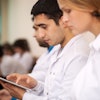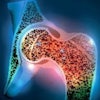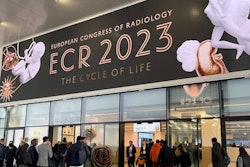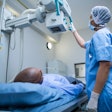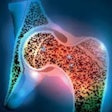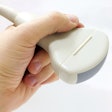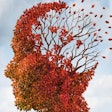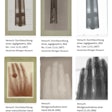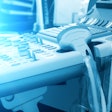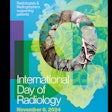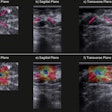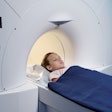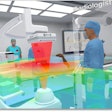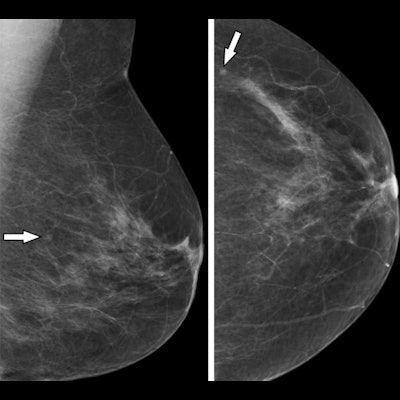
In countries with workforce constraints, could radiographers help with double reading of mammograms? U.K. researchers believe they can, and say their results support the use of physician extenders for breast screening, according to study published on 13 September in Radiology.
A team led by Yan Chen, PhD, associate professor of cancer screening at the University of Nottingham, found no significant differences between radiologists and radiographers for cancer detection rate, recall rates, and positive predictive values.
However, experience does matter, no matter the profession.
"The outcomes of this study may lead screening programs in other countries to consider the use of physician extenders in breast imaging," Chen told AuntMinnieEurope.com.
Double reading of screening mammograms is standard practice in the National Health Service Breast Screening Program in the U.K. Radiographers have been routinely involved with such reading for the past two decades, which has helped in areas where breast radiology programs experience workforce shortages.
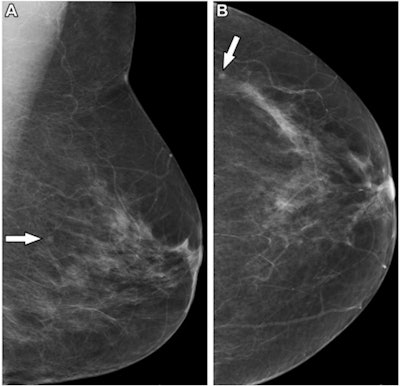 Mammograms in a 50-year-old woman undergoing her first screening mammographic examination show a 3-mm mass (arrow) in the left breast on the (A) mediolateral oblique and the (B) craniocaudal view. It was not recalled by the radiologist who read the mammogram first but was recalled by the radiographer who read the image second. The case was recalled for further assessment after arbitration by a third reader. Ultrasound-guided biopsy showed a 3-mm histologic grade 1 ductal carcinoma. Images courtesy of RSNA.
Mammograms in a 50-year-old woman undergoing her first screening mammographic examination show a 3-mm mass (arrow) in the left breast on the (A) mediolateral oblique and the (B) craniocaudal view. It was not recalled by the radiologist who read the mammogram first but was recalled by the radiographer who read the image second. The case was recalled for further assessment after arbitration by a third reader. Ultrasound-guided biopsy showed a 3-mm histologic grade 1 ductal carcinoma. Images courtesy of RSNA.Radiographers in the U.K. go through reader training and are under the same quality assurance standards as radiologists. Previous research suggests that radiographers can participate in double reading of mammograms, but studies conducted before mammography adopted digital technology also suggest that radiographers have lower reader specificity, higher recall rates, and higher rates of false-positive interpretations.
"With the production of reliable individual reader performance data in recent years it has been possible to produce a robust comparison of the performance of our radiologist and non-radiologist readers in England." Chen said.
Chen et al wanted to compare the performance of radiologists and radiographer readers in double reading mammograms in the U.K. screening program, while also considering differing levels of reading experience.
They looked at data from 401 readers who double-read a total of 1,404,395 screening digital mammograms. The readers included 224 radiologists and 177 radiographers. The study authors measured cancer detection rate, recall rate, and positive predictive value, finding no statistically significant differences between the groups.
| Performance of radiologists vs. radiographers for double reading mammograms | ||
| Radiologist | Radiographers | |
| Cancer detection rate (per 1,000) | 7.84 | 7.53 |
| Recall rate | 5.0% | 5.2% |
| Positive predictive value | 17.1% | 16.1% |
The researchers also found that experience did not matter between the two groups when it came to cancer detection rates. Readers with more than 10 years of experience had a rate of 7.75 per 1,000, compared with 7.71 per 1,000 for readers with five years or fewer years of experience (p = 0.87).
However, experience did matter for recall rates and positive predictive values, regardless of being a radiologist or radiographer. The team found a lower recall rate for readers with more than 10 years of experience (4.8%), compared with five years or fewer (5.8%) (p = 0.001). A higher positive predictive value was seen for readers with more than 10 years of experience (17.5%) compared with five years or less (14.9%) (p = 0.02).
The study authors wrote that employing more trained radiographers for double reading can aid with workforce shortage challenges in breast screening programs in some countries. However, they also called for more research to find out whether physician extender roles could be used to read mammograms independent of radiologists.
Chen told AuntMinnie.com that another potential solution to workforce shortages is to use artificial intelligence (AI) to assist in the reading of screening mammograms.
"We are also looking at performance testing of AI algorithms in the double reading workflow," she said.
In an accompanying editorial, Dr. Regina Hooley and Dr. Melissa Durand from Yale University echoed that implementing either physician extenders or AI for screening mammography could mitigate high breast imaging workloads without sacrificing patient care.
"Both strategies require investment and resources to develop appropriate programs and respective algorithms," they wrote. "Although training and certifying radiographers is a labor-intensive process, the opportunity to do advanced work may attract more mammography technologists to the field of breast imaging."

